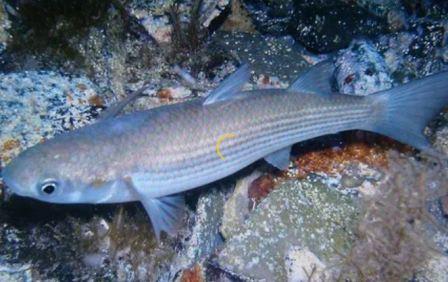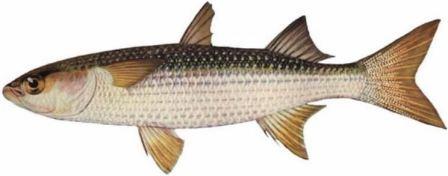Growing golden grey mullet in mariculture
 Golden grey mullet fish photo
Golden grey mullet fish photo
Golden grey mullet is a commercial fish that is caught in the Caspian, Azov, Black, Mediterranean and Atlantic seas. Golden grey mullet is an object of amateur fishing and, thanks to its tasty meat, is in demand on the world market. There are ample opportunities for aquaculture of golden grey mullet. Let's look at what kind of fish Golden grey mullet is, as well as how Golden grey mullet is grown on farms.
Content
- Description of Golden grey mullet fish
- Where does the Golden grey mullet live?
- What does golden grey mullet look like?
- What does golden grey mullet eat?
- Golden grey mullet lifestyle
- Reproduction and spawning of golden grey mullet
- Method of artificial breeding of golden grey mullet
Description of Golden grey mullet fish

What is golden grey mullet fish? Golden grey mullet fish, Latin name Liza aurata, belongs to the mullet family - Mugilidae.
Golden grey mullet fish prefer to stay in schools in the sea.
Where does the Golden grey mullet live?
Golden grey mullet fish lives in the eastern part of the Atlantic from Norway to Cape Verde; golden grey mullet is found in the Black, Azov, Marmara and Mediterranean seas. In 1930, the golden grey mullet (along with the Leaping mullet) was released into the Caspian Sea, where the golden grey mullet took root and reproduced well.
What does golden grey mullet look like?
What does golden grey mullet fish look like? In the Golden grey mullet, the scaly covering on the snout begins behind the rear nostrils. The fatty eyelid around the eye is absent or in its infancy. It lacks an elongated lobe above the base of the pectoral fin. The golden grey mullet has 6–7 longitudinal stripes of brown color on its sides. The body of the golden grey mullet is grey-blue on top, the sides are silvery with longitudinal gray stripes; There are golden spots on the head and gill cover. The anal fin is light in color. In the Caspian Sea, the length of the golden grey mullet reaches 50 cm; in the Black Sea, the length of the golden grey mullet reaches 43 cm.
Golden grey mullet fish are very sensitive to a decrease in water temperature, already at 6–8 ° C the fish stops feeding and migrates from estuaries and sea bays; at 2-3°C it loses mobility, and at a water temperature of 1–1.5°C it dies. For the development and growth of golden grey mullet, the optimal temperature is 23–25° C.
Golden grey mullet fish enters highly desalinated waters (with a salt content of up to 0.05‰), but golden grey mullet is also found in very salty bays (for example, golden grey mullet is found in Sivash in water with a salt content of up to 57‰).
Golden grey mullet fish is unpretentious to the content of oxygen in water, while it tolerates the presence of hydrogen sulfide in water, which is extremely important for the Black Sea.
What does golden grey mullet eat?
Juvenile golden grey mullet, 0.5–1.5 cm long, feed on plankton; when it reaches a length of 2.5–6 cm, it switches to a mixed diet, with the golden grey mullet feeding on plankton, benthic organisms, and detritus; fish with a length of 6 cm and longer switch to feeding on detritus.
Golden grey mullet lifestyle
The Caspian golden grey mullet spends the winter in the deep-sea regions of the southern Caspian Sea off the coast of Iran and in the southeastern part of the sea near Hasan Kuli. Typically, Golden grey mullet migrations to the north begin in April. In summer, its juveniles move from the open parts of the sea to the shallow waters of the western coast in the Middle Caspian. For feeding, the golden grey mullet prefers the muddy, vegetation-covered bottom of estuaries and river mouths.
The Black Sea golden grey mullet approaches the coast in mid-March-April and migrates along them, passing through the Kerch Strait. Penetrates into shallow lagoons and bays, preferring salty or somewhat saline (for example, Sivash) waters, and feeds in them until autumn. Juveniles move somewhat earlier than adults. In the Gelendzhik-Anapa area, the flow of the golden grey mullet from Batumi begins at the end of March, its peak occurs in mid-April, and by the beginning of June the flow usually ends. In August, sexually mature golden grey mullet begins to leave the Sea of Azov and its estuaries. The migration of sexually mature golden grey mullet is observed mainly in August – September. Winters at sea.
Reproduction and spawning of golden grey mullet
How does the golden grey mullet spawn? In the Black Sea, golden grey mullet spawning takes place from July to October in the open sea; In the Caspian Sea, golden grey mullet spawning occurs from mid-August to October, when the water temperature is 17–26° C.
The fertility of golden grey mullet is high and can reach 4,000,000 eggs. Golden grey mullet females lay eggs in one or two stages. Golden grey mullet eggs are floating, spherical with one large or two to four small fat drops. The newly hatched prelarvae are 2.1–2.4 mm long and highly pigmented. During the season from September to April, juvenile golden grey mullet grows to an average of 25–36 mm. By August, the average length of golden grey mullet fry reaches 84 mm. In the Black Sea, males go to spawn for the first time at the age of three to four years, when they reach a length of 20–25 cm, in the Caspian Sea only in the fourth year, when the golden grey mullet reaches a length of 30–32 cm.
Method of artificial breeding of golden grey mullet
During the period of migration of spawners for spawning, golden grey mullet are caught, delivered to the fish hatchery, where intact females of the IV and males of the IV-V stage of maturity are sorted and selected, which are placed in flow-through aerated reinforced concrete pools with a volume of 3 m 3 and kept at a spawning temperature of 19 ° C and salinity 18%.
Selection They feed fish producers at the IV stage of maturity and stimulate their maturation by double injection of a hormonal drug - ecetonated pituitary gland golden grey mullet, which is administered in an amount of 8-14 mg/kg of fish body weight with an interval of 16 hours, with 1/4 initially administered and then 3/4 of the indicated dose.
(When a dose of 8-14 mg/kg is administered, 60-70% of the spawners mature. The percentage of fertilization and hatching of larvae is 60-90%. A double injection ensures better maturation of eggs. The value of the first part of the dose was justified by histological analysis of the eggs of injected fish. Under the influence of the first part dose, the nucleus shifts to the animal pole, the concentration of nucleoli and chromosomes in the nucleus. The introduction of the second part (3/4 of the total dose) ensures the completion of the process of maturation and ovulation of eggs. Mature ovulated eggs are expressed directly into a container with diluted sperm, Ovulated eggs are soft - 0 .7-0.9 mm in diameter. The working fertility of golden grey mullet is 0.6-1 million eggs. Decanting eggs into a container with diluted sperm prevents their thickening, ensures uniform distribution of eggs and sperm and increases fertility by 10-15%. The eggs are washed clean sea water and eggs that are in suspension are selected for incubation - i.e. eggs with a high percentage of fertilization. Eggs are placed in incubation devices at a stocking density of up to 8000 pcs/l and the optimal values of the most important environmental parameters are maintained during the incubation process and are disinfected. Compacted laying of eggs makes it possible to obtain normal viable larvae using fewer devices, which is especially important for golden grey mullet, which has high fertility. After hatching, the larvae are placed in a pool, where they are raised until metamorphosis is completed (40 days). Feeding begins on the 4th-5th day by simultaneously introducing ciliates, rotifers, copepod nauplii and small adult copepods into the container with the larvae. The feeding regimen is based on the experimentally established fact that larvae have high selectivity in nutrition at a very early age. Therefore, the introduction of a variety of foods into the habitat creates better conditions for the transition of larvae to external nutrition and thereby ensures higher survival during early ontogenesis. During the entire growing period, the larvae are kept in water with a salinity of 19-20%, which stimulates their growth and development. For the first 5 days, the water temperature is maintained at 19-20° C, and then after the larvae switch to active feeding, the temperature is increased to 22-23° C. Keeping the larvae in the first 5 days at a relatively low temperature ensures slow resorption of the yolk sac, while lengthening a period of their mixed feeding, which ensures their better survival, and an increase in temperature in subsequent days intensifies the growth of larvae.
The larvae are planted in pools with a density of 50 pcs/l. For the first 5 days, the larvae are grown at 19°C and water salinity 19%, and then over the next 10 days the temperature is gradually increased to 23°C and maintained until the end of cultivation. The content of dissolved oxygen during the growing period is 7.5 ml/l, pH 8.1, ammonia content is not more than 15 μg atom/l. On the 4th day, when the larvae have begun to grow, ciliates of the genera Flntinnopsls, Mlsodinlum, Euplotes, rotifers - Brachionus pllcatills, nauplii copepods Acartla claust, Harpacticus litoralis, Oithona minuta, and adult small copepods Oithona minuta are simultaneously introduced into the pool.
The concentration of ciliates is maintained at 50 specimens/ml, rotifers up to 10 specimens/ml, copepod nauplii and adult copepods at 6 specimens/ml. The larvae switch to active feeding on the 5-6th day. At the same time, their swim bladder fills with air. In the following days, the larvae continue to be fed with nauplii and adult copepods, Artemia nauplii and artificial granular food. At the age of 40 days, the larvae complete metamorphosis.